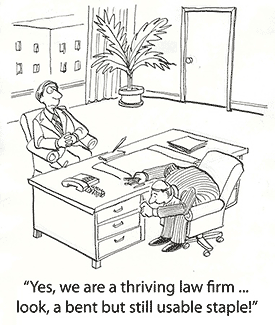USA
Why The Other Person Got the Better Deal - The Law of Power
 The Law of Power says: The person with the greater power, real or imagined, will get the better deal in any negotiation.
The Law of Power says: The person with the greater power, real or imagined, will get the better deal in any negotiation.
Your ability to recognize both your power and the power of the other person is critical to success in negotiating. Often you have more power than you know and the other party less.
- The first corollary of the Law of Power says: “No one will negotiate with you unless they feel you have the power to help them or hurt them in some way.” You must have something the other person wants, or be able to withhold something he wants.
- The second corollary of this law says: “Power is a matter of perception; it is in the eye of the beholder.” You can often create the perception of power with boldness and creativity.
Of the three keys to negotiating – power, preparation, and timing – power is often the most important.
Further, there are 10 different types of power you can develop and use to influence and persuade the other party in any negotiation. What are these levers of power and how can you use them?
- from "THE 100 ABSOLUTELY UNBREAKABLE LAWS OF BUSINESS SUCCESS" – Brian Tracy
Dealing with Difficult People
 Is a co-worker difficult? You need your team working toward a positive goal, so confront the problem. Here are some practical steps:
Is a co-worker difficult? You need your team working toward a positive goal, so confront the problem. Here are some practical steps:
- Find Out If It’s Just You. Look for signs that indicate several people have the same concern.
- Control the Narrative. Assume control of the narrative by identifying and proposing solutions or improvements.
- Have a Difficult Conversation. Ask to have an honest discussion about an issue or a problem you see. This will alert the co-worker to the importance of the situation without making him or her defensive.
- Address the Problem, Not the Person. Avoid accusing or blaming. Approach the issue indirectly and follow it up with a shift toward a solution.
- Stand Firm. Many people have “bully” tendencies. If you stand up for yourself, politely and firmly, and the problem is very likely to go away.
- Walk a Mile in Their Shoes. Remember that often people are difficult because they are dealing with problems of their own.
- Choose Your Battles. When your situation is temporary or doesn’t affect your work, you might find it easier to avoid associating with the difficult person or to simply grit your teeth until it’s over.
Why The Future of Our Economy Is Small Business
 Healthy, growing small businesses are the life blood of our economy. Yet many are just trudging along. Most business owners spend more time in their business than they do with their families.
Healthy, growing small businesses are the life blood of our economy. Yet many are just trudging along. Most business owners spend more time in their business than they do with their families.
Why? It’s because these founders are business operators rather than business owners. They believe they are the only person who can do the job right or that it would take too much time to train someone else.
To change this, you can use the “Power of Leverage.” There are seven leverage strategies that you can use:
- Other People’s Energy
- Other People’s Knowledge
- Other People’s Money
- Other People’s Successes
- Other People’s Failures
- Other People’s Ideas
- Other People’s Contacts
When we work with businesses hoping to grow, only 20 percent of the constraint is technical – 80 percent is the psychology, the mindset, the fears, worries, and concerns of the owner.
As business success strategists, we have dozens of proven strategies to move you to the level of success you want. Importantly, we work alongside you to help you with the mind shift needed to move from operator to business owner.
Marketing Automation: The Key to Growth
 Marketing activities are labor intensive and time-consuming. Automated marketing strategies give you the tools to grow without significant outlays of cash and already scarce resources.
Marketing activities are labor intensive and time-consuming. Automated marketing strategies give you the tools to grow without significant outlays of cash and already scarce resources.
The customer relationship progresses through many tiny steps. Automated marketing lets you guide interested leads through the initial research, product inquiry, and purchase phases of the sales funnel in a way that isn’t pushy or overbearing. It also helps you grow an email list you can use to build relationships with clients and potential clients and mine for future business. Here’s what marketing automation can do:
- Lead Acquisition. This includes SEO tools, automated content posting. and social profile management.
- Prospect Evaluation and Consideration of Options. Capture prospect information via opt-in for emails or newsletters, trigger emails based on behavior, and automate email campaigns.
- Decision-Making, Cultivation, and Profiling. Automate emails through welcoming and onboarding, send reminders, promote specials, collect user information to improve targeting, manage loyalty program and publish blogs and newsletters.
- Termination and Win-Back. Conduct data collection and exit surveys as well as send automated win-back emails at six and 12-month intervals.
Among the cloud-based marketing automation services available are Marketing Essentials, Leadsius, InTouch, and ActiveCampaign.
How to Franchise Your Business
 Considering franchising your business? There are many factors to handle beyond what you know about running your business. Joe McCord, VP of The Franchise Doctor Inc., offers 14 guidelines to determine if your company may be franchisable:
Considering franchising your business? There are many factors to handle beyond what you know about running your business. Joe McCord, VP of The Franchise Doctor Inc., offers 14 guidelines to determine if your company may be franchisable:
- Feasibility. Can franchisees make a minimum of $50,000 a year and get their expected ROI?
- Pride in the concept. What attitudes, outlook, vision, and mission differentiate you from similar businesses?
- Who is the customer? How big is the market?
- Who are the competitors?
- What makes the business different?
- What type of business is this? Retail, B2B, or another model?
- WWYDDKWYNK? What would you do differently now knowing what you now know?
- What’s required for success? Are these teachable to the average owner?
- Learnable process. Can the average person learn the business in two or three weeks?
- Training programs. Do you have the training programs and support a franchise requires?
- KAIZAN. Do you have a way to measure training effectiveness?
- Are you prepared to invest the money and time, and change your role in the business?
- Are your growth expectations realistic?
- How to market and sell a franchise. Marketing a franchise takes new skills and knowledge.




